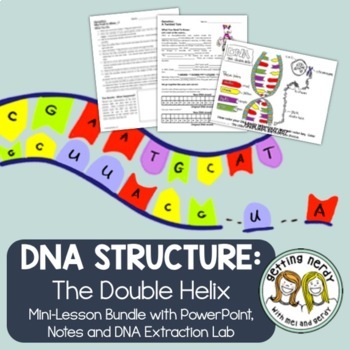DNA History, Structure and Function - PowerPoint and Notes
- Zip
What educators are saying
Description
Bring the structure of DNA to life for your middle school science students with this resource that would make Watson, Crick AND Franklin proud. In this lesson, students learn the history of DNA discovery, demonstrate how nucleic acids pair with one another, and observe DNA with the naked eye.
This 1-2 day lesson includes a presentation that guides students through the history and structure of DNA, including topics such as Chargraff's rule and base-pairing rules. Students then complete sequences of DNA and RNA, color and label a section of DNA and close the lesson with a fruit extraction lab that makes DNA visible to the naked eye.
This is a great introductory lesson to the structure and history of deoxyribonucleic acid and could easily lead into a more in-depth review of DNA, genes, chromosomes, or protein synthesis. Expand on this lesson by offering other types of fruit for extraction and comparing the results or offering more practice creating DNA and RNA sequences.
WHAT'S INCLUDED in this 1-2 DAY LESSON:
• EDITABLE PPT Presentation
→ Lesson introduction slide with objective and warm-up
→ Notes aligning with PDF
→ Lesson/Lab instructions
→ Embedded answer keys
• NON-EDITABLE PDF handouts
→ Student note-taking pages
→ Student lab instructions
→ Teacher guide and answer key
STUDENTS WILL:
• Use the PPT to learn about and take notes on the history and structure of DNA
• Learn about and demonstrate understanding of how nucleic acids form base pairs
• Complete a fruit DNA extraction lab
• Answer extension questions
TEACHERS LOVE THIS, HERE'S WHY:
❤️Kate D. says, "Absolutely fantastic resource! My students REALLY enjoyed this resource. The notes lay out the concept well; none of my seventh graders struggled to understand. Thank you!"
❤️ The Megan S. says, "I've never seen my kiddos so engaged in a science lesson! We went through the PPT to gain background knowledge (1 day) and then completed the lab. WOW! My kiddos loved the hands-on experience and were so excited to see if fruit really had DNA..."
❤️ Katlind K. says, "This is a great, short introduction to DNA and base pairing. Easy to use and loved the interactiveness with the students having to color and identify matching base pairs!"
THIS PRODUCT IS ALSO FOUND IN OUR:
• Life Science Curriculum Bundle
CHECK OUT OUR OTHER GENETICS RESOURCES:
• Fortune Teller Life Science Vocabulary Bundle
• WinterThemed Punnett Square Practice Problems and Activity
• Fall Themed Punnett Square Practice Problems and Activity
SEE HOW THIS LESSON ALIGNS WITH NGSS, TEKS or GSE
Because we have created many of our own graphics or have purchased licenses to other graphics with permission, we cannot offer our resources in editable format unless otherwise stated.
TERMS OF USE (TOU):All rights reserved by GETTING NERDY®️.
• This product is to be used by the original purchaser only
• Intended for classroom and personal use only
• Copying for more than one teacher, classroom, department, school, or school system is prohibited.
• This product may not be distributed or displayed digitally for public view
Failure to comply is a copyright infringement and a violation of the Digital Millennium Copyright Act (DMCA). Clipart and elements found in this PDF are copyrighted and cannot be extracted and used outside of this file without permission or license.
DNA History, Structure and Function - PowerPoint and Notes © 2012 to present GETTING NERDY®️ All Rights Reserved





